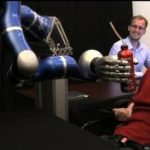Cathy Hutchinson, 59, suffered a stroke more than 15 years ago. The stroke paralyzed her arms and legs, leaving her unable to care for herself. Although her brain functioned normally, she could no longer speak. Hutchinson made international news when researchers reported that she was able to successfully drink a sip of coffee using a robotic arm that she controlled with her thoughts.

Electrodes Record Brain Activity
Hutchinson signed up to take part in a clinical trial to determine if she could use her thoughts to create movement. As a part of the trial, a tiny device was implanted into her brain at the motor cortex. This device, approximately the size of a pill, is called BrainGate. The BrainGate device is covered in electrodes that can record brain activity in the motor cortex. The motor cortex is the part of the brain that controls voluntary motor skills.
The success of the study relied on training both Hutchinson and the computer that controlled the robotic arm. The researchers would make the arm move in a certain way and tell Hutchinson to envision her own arm performing the same act. The electrodes on the device in her brain would record her thoughts and associate those thoughts with the movement that the robotic arm had completed. The device is connected to a computer by a cable attached to the patient’s skull.
Stroke victims think, Robotic Arm acts
Through the reading of the electrodes, the computer learned how to translate Hutchinson’s thoughts into movement. Once the computer was able to associate Hutchinson’s thoughts with a certain movement, it became possible for Hutchinson to control the robotic arm using only her thoughts. Even though Hutchinson had been paralyzed for 15 years, her brain still transmitted signals that corresponded to movement in her hands and her arms.
Hutchinson said that she envisioned her own arm grasping the cup and bringing it to her lips. The robotic arm performed the same act that she had visualized, allowing her to sip the coffee through a straw. This sip was the first drink that she was able to take without being assisted by another person in the 15 years since the stroke left her paralyzed. In the trials, she was successful in controlling the robotic arm four out of six times in less than 10 minutes. She said that the experience gave her an incredible sense of independence that she had lacked ever since she suffered the stroke.
Thought-Controlled Robotics Restore Mobility to Quadriplegics
A team of brain scientists have been working on thought-controlled technology for more than a decade. The team is led by researchers from Brown University, Massachusetts General Hospital and the Providence VA Medical Center. Earlier trials had participants move a cursor on a computer screen using only their thoughts. They were able to successfully check their email on their own.
[Read also: New Device allows Deaf-Blind to Text Messages]
Researchers are pleased with the success of this trial and believe it shows promise for creating prosthetic devices that allow quadriplegics to control movement with their thoughts. If successful, the technology will bridge an important gap, serving people who are paralyzed but maintain full brain function. This project’s success demonstrates tremendous promise to allow for the mobility of quadriplegics and others who have suffered strokes or spinal cord injuries. This technology will also be important to help war veterans regain mobility after suffering paralysis. Although this technology is promising, it is unlikely to be available for several years.
[Read also: Festo Introduces The ExoHand]

Could be an important breakthrough. They say aliens use symbiotic engines so that might be the next step for us as well.
We’re on the cusp of something really great. The technology available today stands to improve the lives of those who never dreamed of having these capabilities. As long as this technology is used in the right way, we’re in for some really amazing times.